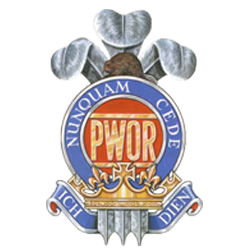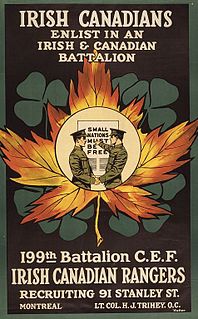| 133rd Battalion (Norfolk's Own), CEF | |
|---|---|
 Pin design for the 133rd Battalion (Norfolk's Own), CEF | |
| Active | December 22, 1915-July 17, 1917 |
| Country | Canada |
| Branch | Army |
| Part of | Canadian Expeditionary Force |
| Garrison/HQ | Simcoe, Ontario |
The 133rd Battalion (Norfolk's Own), CEF was a unit in the Canadian Expeditionary Force during the First World War.

The Canadian Expeditionary Force (CEF) was the designation of the field force created by Canada for service overseas in the First World War. The force fielded several combat formations on the Western Front in France and Belgium, the largest of which was the Canadian Corps, consisting of four divisions. The Canadian Cavalry Brigade and the Canadian Independent Force, which were independent of the Canadian Corps, also fought on the Western Front. The CEF also had a large reserve and training organization in England, and a recruiting organization in Canada. In the later stages of the European war, particularly after their success at Vimy Ridge and Passchendaele, the Canadian Corps was regarded by friend and foe alike as one of the most effective Allied military formations on the Western Front. In August 1918, the CEF's Canadian Siberian Expeditionary Force travelled to revolution-torn Russia. It reinforced an anti-Bolshevik garrison in Vladivostok during the winter of 1918–19. At this time, another force of Canadian soldiers were placed in Archangel, where they fought against Bolsheviks.

World War I, also known as the First World War or the Great War, was a global war originating in Europe that lasted from 28 July 1914 to 11 November 1918. Contemporaneously described as "the war to end all wars", it led to the mobilisation of more than 70 million military personnel, including 60 million Europeans, making it one of the largest wars in history. It is also one of the deadliest conflicts in history, with an estimated nine million combatants and seven million civilian deaths as a direct result of the war, while resulting genocides and the resulting 1918 influenza pandemic caused another 50 to 100 million deaths worldwide.
Based in Simcoe, Ontario, Canada, the unit began recruiting during the later months of 1915 in Norfolk County; recruiting more than 400 men in the process. [1] After sailing to England in November 1916, the battalion was absorbed into the 23rd Reserve Battalion, CEF on November 11, 1916, in order to provide reinforcements for the Canadian Corps who were active in the field. The 133rd Battalion (Norfolk's Own), CEF had one officer commanding: Lieutenant-Colonel A. C. Pratt. [2] The battalion was disbanded on July 17, 1917.

Simcoe is an unincorporated community and former town in Southwestern Ontario, Canada near Lake Erie. It is the county seat and largest community of Norfolk County. Simcoe is at the junction of Highway 3, at Highway 24, due south of Brantford, and accessible to Hamilton by nearby Highway 6. This largest of the Communities in Norfolk County, Ontario had a population of 13,922 at the time of the 2016 Census.

Ontario is one of the 13 provinces and territories of Canada. Located in Central Canada, it is Canada's most populous province accounting for 38.3 percent of the country's population, and is the second-largest province in total area. Ontario is fourth-largest jurisdiction in total area when the territories of the Northwest Territories and Nunavut are included. It is home to the nation's capital city, Ottawa, and the nation's most populous city, Toronto, which is also Ontario's provincial capital.

Canada is a country in the northern part of North America. Its ten provinces and three territories extend from the Atlantic to the Pacific and northward into the Arctic Ocean, covering 9.98 million square kilometres, making it the world's second-largest country by total area. Its southern border with the United States, stretching some 8,891 kilometres (5,525 mi), is the world's longest bi-national land border. Canada's capital is Ottawa, and its three largest metropolitan areas are Toronto, Montreal, and Vancouver.
The 133rd Battalion is perpetuated by the 56th Field Artillery Regiment, RCA . [3]
The 56th Field Artillery Regiment, Royal Canadian Artillery is a Canadian Army Reserve artillery regiment based in Brantford, Ontario. The regiment is currently part of 4th Canadian Division's 32 Canadian Brigade Group.






